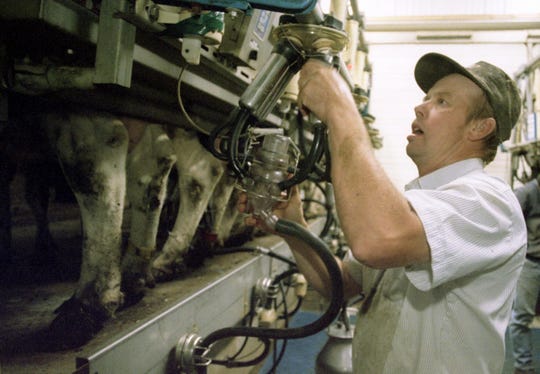Most farmers – while they are experts in many aspects of their business – don’t understand the federal milk pricing system and don’t trust it either, says Pete Hardin, editor and publisher of the monthly dairy publication called The Milkweed.
“It seems like it’s intentionally designed to be so complex that people don’t even know the right questions to ask,” he said. “Farmers make milk all month long and don’t know what they’re going to be paid for it.”
Record cheese prices at the Chicago Mercantile Exchange should translate into good checks for farmers, but how their milk handler decides to deal with things like Producer Price Differentials (PPDs) and depooling will affect what the dairy producer gets in that milk check.
Hardin calls it a “very unhealthy situation for the dairy industry” noting that dairy farmers “just want to see the money” that’s in the marketplace that they’ve been hearing about since May.
Some of those who understand the system better than others have worried that the wildly swinging milk prices and what look to be persistently negative PPDs which could last through the end of the year, might create winners and losers in the USDA’s Dairy Margin Coverage safety net program and for other risk management programs.
That brings us to the National Agricultural Statistical Service or NASS “all-milk price.” It’s important because it is used to settle payments for DMC and the Dairy Revenue Protection insurance program. This all-important all-milk price is defined as a measurement of what plants paid the non-members and cooperatives for milk delivered to the plant before deductions for hauling. It includes quality and volume premiums for standard butterfat milk. The NASS price should include the amount paid for the “not pooled milk.”
In response to questions from Farmshine reporter Sherry Bunting, the USDA explained that “if some higher value milk is not in the ‘pool’ then the weighted average price will be lower.” That highlights the importance of depooling.
The USDA also told Bunting: “It is important to note that the Class III money still exists in the marketplace. It is just that manufacturing handlers are not required to share that money through the regulated pool.”
‘damning to the core of the milk pricing system’
Hardin calls that assertion “damning to the core of the milk pricing system.”
He believes major changes are needed in the Federal Milk Marketing Order system, a program that was instituted in the 1930s to assure “a fresh, wholesome and adequate supply of fluid milk and to promote orderly milk marketing.” With milk dumping in several milk orders on a regular basis (not just during the pandemic), chaotic conditions and now with persistently negative PPDs “I would argue that milk marketing is no longer orderly. The timing is right for a change,” he said.
Farmers don’t really care that much about the technical details, he said, “they want to see the money after what they’ve been through this spring and most of the past five years.”
Hardin explains that if the block price was $3 per pound and the barrel cheese was $2.40 per pound for a given month and utilization was about the same then the average of the two would be the benchmark – not that pie-in-the-sky $3.
Producers got a wide variety of pay prices from their dairy plants or cooperatives in the last milk check. Hardin says that in Wisconsin – where 85 to 90 percent of the milk goes into cheese vats – there is a lot more competition for farm milk, “than just about any other place in the country and it helps keep firms honest.”
Changes needed
Hardin believes we don’t need four classes of milk – two would be fine. Class I would include milk for cheese, for bottling and for yogurt. “We don’t need to keep worshiping fluid milk as we do now with Class I pricing. Cheese and yogurt are just as valuable in the marketplace. In New Zealand all milk components, fat and non-fat solids have the same value.”
In his plan, Class II would cover everything else. “We are always going to need a separate price for milk processed into non-fat dry milk.” Further, he says the dairy industry could get by with one, two or three federal milk marketing orders. “We don’t need all these federal orders with different rules for pooling.”
Our 85-year-old milk pricing system in its current form is one that very few people understand or trust, he said. “Economists can explain technical nuances but in some cases those technical nuances are what’s wrong with the system.”
Richard Bylsma, National Director of Dairy Sales for NFO, agrees that “times are so strange that our federal order system can’t handle it.” Bottlers are worried because the cheese market is hotter than their market, he added.
In May 2019, the price mover for Class I (fluid) milk was changed through a provision in the last farm legislation. That happened because Class I processors wanted the ability to use forward contracting for price protection. The change happened through legislation because two major dairy lobbying groups agreed to it.
Now, Class III and Class IV prices are averaged and 74 cents is added to determine the Class I price mover. The negative PPDs seen today are the result of Class III being larger than the uniform blended price; the large amount of depooling that resulted keeps the higher value from being shared in the pool.
Taking farmers’ money
Bylsma said that depooling allows some plants to take advantage of the federal order system when it’s to their advantage but adds that it also “takes money out of farmers’ pockets.”
Here’s how. Take a cheese factory somewhere in Wisconsin, for example with a pay price of $21.04 per hundredweight. If they depool, that brings the blended price to $18 and they can keep the difference. That amounts to what Bylsma called a “windfall profit” for that cheese factory because of depooling. As the USDA told Farmshine, it’s up to each milk handler to determine how much of that money to share with milk producers.
Bylsma agrees that the time is right to make significant changes in the federal milk marketing order system. “We at NFO support the federal order system and think it has served our industry well, but it’s not perfect. Our position is that we should keep and enhance it and give it more authority. We need a mechanism to make changes almost overnight – not by waiting for Congress or the USDA.”
His organization favors a system with one national milk order for the lower 48 states. When the federal orders were created there were similar areas of supply and demand. For example, New York City got its milk from upstate New York, Vermont and Pennsylvania. Chicago’s milk came from Wisconsin and Illinois.
“Then there were real identifiable regional lines. But now those defined lines are gone. That Walmart plant in Indiana ships milk into four different milk orders,” Bylsma said.
He’s sensitive to the problem posed by milk prices as it relates to the DMC safety net. He notes that Michigan farmers got $13 per hundredweight mailbox prices last fall, compared to $20 per hundredweight in Florida; yet both got the same amount of money under the DMC.













